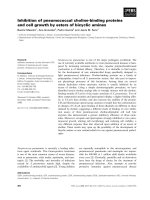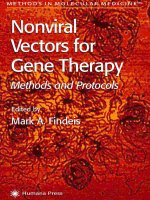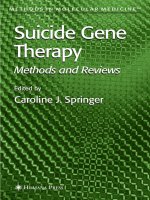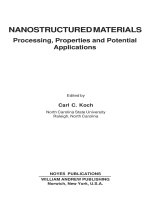Gene Therapy - Tools and Potential Applications by Francisco Martin Molina Contributors ppt
Bạn đang xem bản rút gọn của tài liệu. Xem và tải ngay bản đầy đủ của tài liệu tại đây (27.33 MB, 754 trang )
GENE THERAPY - TOOLS
AND POTENTIAL
APPLICATIONS
Edited by Francisco Martin Molina
Gene Therapy - Tools and Potential Applications
/>Edited by Francisco Martin Molina
Contributors
Qiuhong Li, David Escors, Therese Liechtenstein, Ines Dufait, Grazyna Kochan, Karine Breckpot, Roberta Laranga,
Antonella Padella, Christopher Bricogne, Frederick Arce, Alessio Lanna, Angel Zarain-Herzberg, Gabriel MorenoGonzález, Oleg E Tolmachov, Tatiana Subkhankulova, Tanya Tolmachova, Kohji Itoh, Aurore Burgain-Chain, Daniel
Scherman, Matthew Wilson, Dimitrios Dougenis, Dimosthenis Lykouras, Kostas Spiropoulos, Kiriakos Karkoulias,
Christos Tourmousoglou, Efstratios Koletsis, Kazuto Kobayashi, Shigeki Kato, Kazuhisa Bessho, Hiroshi Tomita, Isaura
Tavares, Devendra Agrawal, Jian Wu, Alicia Rodríguez Gascón, Mark Tangney, David Morrissey, Grant Trobridge,
Dustin Rae, Cleo Goyvaerts, Helen McCarthy, Cian McCrudden, Ann Simpson, Jose C Segovia, María García-Gómez,
Oscar Quintana-Bustamante, Susana Navarro, Maria Garcia-Bravo, Zita Garate, Elisabeth Mayr, Johann W Bauer, Ulrich
Koller, George Kotzamanis, Athanassios Kotsinas, Vassilis Gorgoulis, Apostolos Papalois, Ana Coroadinha, Hélio Tomỏs,
Paula M. Alves, Ana Rodrigues, Christopher Porada, Graỗa Almeida-Porada, Takashi Okada, Xiaoling Zhang, Shengnan
Xiang, Ana Calvo, Ian S. Blagbrough, Francisco Martin
Published by InTech
Janeza Trdine 9, 51000 Rijeka, Croatia
Copyright © 2013 InTech
All chapters are Open Access distributed under the Creative Commons Attribution 3.0 license, which allows users to
download, copy and build upon published articles even for commercial purposes, as long as the author and publisher
are properly credited, which ensures maximum dissemination and a wider impact of our publications. After this work
has been published by InTech, authors have the right to republish it, in whole or part, in any publication of which they
are the author, and to make other personal use of the work. Any republication, referencing or personal use of the
work must explicitly identify the original source.
Notice
Statements and opinions expressed in the chapters are these of the individual contributors and not necessarily those
of the editors or publisher. No responsibility is accepted for the accuracy of information contained in the published
chapters. The publisher assumes no responsibility for any damage or injury to persons or property arising out of the
use of any materials, instructions, methods or ideas contained in the book.
Publishing Process Manager Danijela Duric
Technical Editor InTech DTP team
Cover InTech Design team
First published March, 2013
Printed in Croatia
A free online edition of this book is available at www.intechopen.com
Additional hard copies can be obtained from
Gene Therapy - Tools and Potential Applications, Edited by Francisco Martin Molina
p. cm.
ISBN 978-953-51-1014-9
free online editions of InTech
Books and Journals can be found at
www.intechopen.com
Contents
Preface IX
Section 1
Introduction 1
Chapter 1
Non-Viral Delivery Systems in Gene Therapy 3
Alicia Rodríguez Gascón, Ana del Pozo-Rodríguez and María
Ángeles Solinís
Chapter 2
Plasmid Transgene Expression in vivo: Promoter and Tissue
Variables 35
David Morrissey, Sara A. Collins, Simon Rajenderan, Garrett Casey,
Gerald C. O’Sullivan and Mark Tangney
Chapter 3
Silencing of Transgene Expression: A Gene Therapy
Perspective 49
Oleg E. Tolmachov, Tatiana Subkhankulova and Tanya Tolmachova
Section 2
Gene Therapy Tools: Synthetic 69
Chapter 4
Cellular Uptake Mechanism of Non-Viral Gene Delivery and
Means for Improving Transfection Efficiency 71
Shengnan Xiang and Xiaoling Zhang
Chapter 5
Polylipid Nanoparticle, a Novel Lipid-Based Vector for Liver
Gene Transfer 91
Yahan Fan and Jian Wu
Chapter 6
DNA Electrotransfer: An Effective Tool for Gene Therapy 109
Aurore Burgain-Chain and Daniel Scherman
Chapter 7
siRNA and Gene Formulation for Efficient Gene Therapy 135
Ian S. Blagbrough and Abdelkader A. Metwally
VI
Contents
Section 3
Gene Therapy Tools: Biological 175
Chapter 8
Mesenchymal Stem Cells as Gene Delivery Vehicles 177
Christopher D. Porada and Graỗa Almeida-Porada
Chapter 9
Cancer Gene Therapy – Key Biological Concepts in the Design
of Multifunctional Non-Viral Delivery Systems 213
Cian M. McCrudden and Helen O. McCarthy
Chapter 10
Gene Therapy Based on Fragment C of Tetanus Toxin in ALS: A
Promising Neuroprotective Strategy for the Bench to the
Bedside Approach 249
Ana C. Calvo, Pilar Zaragoza and Rosario Osta
Chapter 11
Transposons for Non-Viral Gene Transfer 269
Sunandan Saha and Matthew H. Wilson
Chapter 12
Lentiviral Gene Therapy Vectors: Challenges and Future
Directions 287
Hélio A. Tomás, Ana F. Rodrigues, Paula M. Alves and Ana S.
Coroadinha
Chapter 13
Lentiviral Vectors in Immunotherapy 319
Ines Dufait, Therese Liechtenstein, Alessio Lanna, Roberta Laranga,
Antonella Padella, Christopher Bricogne, Frederick Arce, Grazyna
Kochan, Karine Breckpot and David Escors
Chapter 14
Targeted Lentiviral Vectors: Current Applications and Future
Potential 343
Cleo Goyvaerts, Therese Liechtenstein, Christopher Bricogne, David
Escors and Karine Breckpot
Chapter 15
Vectors for Highly Efficient and Neuron-Specific Retrograde
Gene Transfer for Gene Therapy of Neurological Diseases 387
Shigeki Kato, Kenta Kobayashi, Ken-ichi Inoue, Masahiko Takada
and Kazuto Kobayashi
Chapter 16
Retroviral Genotoxicity 399
Dustin T. Rae and Grant D. Trobridge
Contents
Chapter 17
Section 4
Efficient AAV Vector Production System: Towards Gene
Therapy For Duchenne Muscular Dystrophy 429
Takashi Okada
Applications: Inhereted Diseases 451
Chapter 18
Gene Therapy for Primary Immunodeficiencies 453
Francisco Martin, Alejandra Gutierrez-Guerrero and Karim
Benabdellah
Chapter 19
Gene Therapy for Diabetic Retinopathy – Targeting the
Renin-Angiotensin System 467
Qiuhong Li, Amrisha Verma, Ping Zhu, Bo Lei, Yiguo Qiu, Takahiko
Nakagawa, Mohan K Raizada and William W Hauswirth
Chapter 20
Gene Therapy for Retinitis Pigmentosa 493
Hiroshi Tomita, Eriko Sugano, Hitomi Isago, Namie Murayama and
Makoto Tamai
Chapter 21
Gene Therapy for Erythroid Metabolic Inherited Diseases 511
Maria Garcia-Gomez, Oscar Quintana-Bustamante, Maria GarciaBravo, S. Navarro, Zita Garate and Jose C. Segovia
Chapter 22
Targeting the Lung: Challenges in Gene Therapy for Cystic
Fibrosis 539
George Kotzamanis, Athanassios Kotsinas, Apostolos Papalois and
Vassilis G. Gorgoulis
Chapter 23
Gene Therapy for the COL7A1 Gene 561
E. Mayr, U. Koller and J.W. Bauer
Chapter 24
Molecular Therapy for Lysosomal Storage Diseases 591
Daisuke Tsuji and Kohji Itoh
Section 5
Chapter 25
Applications: Others 609
Gene Therapy Perspectives Against Diseases of the
Respiratory System 611
Dimosthenis Lykouras, Kiriakos Karkoulias, Christos
Tourmousoglou, Efstratios Koletsis, Kostas Spiropoulos and
Dimitrios Dougenis
VII
VIII
Contents
Chapter 26
Gene Therapy in Critical Care Medicine 631
Gabriel J. Moreno-González and Angel Zarain-Herzberg
Chapter 27
Clinical and Translational Challenges in Gene Therapy of
Cardiovascular Diseases 651
Divya Pankajakshan and Devendra K. Agrawal
Chapter 28
Gene Therapy for Chronic Pain Management 685
Isaura Tavares and Isabel Martins
Chapter 29
Insulin Trafficking in a Glucose Responsive Engineered Human
Liver Cell Line is Regulated by the Interaction of ATP-Sensitive
Potassium Channels and Voltage-Gated Calcium
Channels 703
Ann M. Simpson, M. Anne Swan, Guo Jun Liu, Chang Tao, Bronwyn
A O’Brien, Edwin Ch’ng, Leticia M. Castro, Julia Ting, Zehra Elgundi,
Tony An, Mark Lutherborrow, Fraser Torpy, Donald K. Martin,
Bernard E. Tuch and Graham M. Nicholson
Chapter 30
Feasibility of Gene Therapy for Tooth Regeneration by
Stimulation of a Third Dentition 727
Katsu Takahashi, Honoka Kiso, Kazuyuki Saito, Yumiko Togo,
Hiroko Tsukamoto, Boyen Huang and Kazuhisa Bessho
Preface
In the last 10 years gene therapy has experienced a renascence thanks to the development of
safer and more efficient gene transfer vectors and to the advances in the cell therapy field.
This book brings together a comprehensive collection of gene therapy tools and their thera‐
peutic applications. The first part of the book covers different gene therapy vectors focusing
on their advantages and disadvantages. The second part of the book gets into gene therapy
applications, from the latest successes on clinical trials to the new gene therapy targets that
are still under development. This book allows the reader to come across with the opinions of
different experts in the gene therapy field.
Francisco Martín Molina
Principal Investigator
Gene and Cell Therapy group
Pfizer - Universidad de Granada - Junta de Andalucía Centre for Genomics and
Oncological Research (GENYO)
Section 1
Introduction
Chapter 1
Non-Viral Delivery Systems in Gene Therapy
Alicia Rodríguez Gascón,
Ana del Pozo-Rodríguez and María Ángeles Solinís
Additional information is available at the end of the chapter
/>
1. Introduction
Recent advances in molecular biology combined with the culmination of the Human Ge‐
nome Project [1] have provided a genetic understanding of cellular processes and disease
pathogenesis; numerous genes involved in disease and cellular processes have been identi‐
fied as targets for therapeutic approaches. In addition, the development of high-throughput
screening techniques (e.g., cDNA microarrays, differential display and database meaning)
may drastically increase the rate at which these targets are identified [2,3]. Over the past
years there has been a remarkable expansion of both the number of human genes directly
associated with disease states and the number of vector systems available to express those
genes for therapeutic purposes. However, the development of novel therapeutic strategies
using these targets is dependent on the ability to manipulate the expression of these target
genes in the desired cell population. In this chapter we explain the concept and aim of gene
therapy, the different gene delivery systems and therapeutic strategies, how genes are deliv‐
ered and how they reach the target.
2. Aim and concept of gene therapy with non-viral vectors
A gene therapy medicinal product is a biological product which has the following character‐
istics: (a) it contains an active substance which contains or consists of a recombinant nucleic
acid used in administered to human beings with a view to regulating, repairing, replacing,
adding or deleting a genetic sequence; (b) its therapeutic, prophylactic or diagnostic effect
relates directly to the recombinant nucleic acid sequence it contains, or to the product of ge‐
netic expression of this sequence [4].
© 2013 Gascón et al.; licensee InTech. This is an open access article distributed under the terms of the
Creative Commons Attribution License ( which permits
unrestricted use, distribution, and reproduction in any medium, provided the original work is properly cited.
4
Gene Therapy - Tools and Potential Applications
The most important, and most difficult, challenge in gene therapy is the issue of delivery.
The tools used to achieve gene modification are called gene therapy vectors and they are the
“key” for an efficient and safe strategy. Therefore, there is a need for a delivery system,
which must first overcome the extracellular barriers (such as avoiding particle clearance
mechanisms, targeting specific cells or tissues and protecting the nucleic acid from degrada‐
tion) and, subsequently, the cellular barriers (cellular uptake, endosomal escape, nuclear en‐
try and nucleic release) [5]. An ideal gene delivery vector should be effective, specific, long
lasting and safe.
Gene therapy has long been regarded a promising treatment for many diseases, including
inherited through a genetic disorder (such as hemophilia, human severe combined immuno‐
deficiency, cystic fibrosis, etc) or acquired (such as AIDS or cancer). Figures 1 and 2 show
the indications addressed and the gene types transferred in gene therapy clinical trials, re‐
spectively [6].
Indications addressed by gene therapy clinical trials
Cancer diseases
Cardiovascular diseases
Gene marking
Healthy volunteers
Infectious diseases
Inflammatory diseases
Monogenic diseases
Neurological diseases
Ocular diseases
Others
Figure 1. Indications addressed by gene therapy clinical trials (adapted from .k/genmed/clinical).
Gene delivery systems include viral vectors and non-viral vectors. Viral vectors are the most
effective, but their application is limited by their immunogenicity, oncogenicity and the
small size of the DNA they can transport. Non-viral vectors are safer, of low cost, more re‐
producible and do not present DNA size limit. The main limitation of non-viral systems is
their low transfection efficiency, although it has been improved by different strategies and
the efforts are still ongoing [6]; actually, advances of non-viral delivery have lead to an in‐
creased number of products entering into clinical trials. However, viral vector has dominat‐
ed the clinical trials in gene therapy for its relatively high delivery efficiency. Figure 3 shows
the proportion of vector systems currently in human trials [7].
Non-Viral Delivery Systems in Gene Therapy
/>
Gene types trasnferred in gene therapy clinical trials
Adhesion molecule
Antigen
Antisense
Cell cycle
Cell protection/Drug resistance
Cytokine
Deficiency
Grow th factor
Hormone
Marker
Oncogene regulator
Oncolytic virus
Porins, ion channels, transporters
Receptor
Replication inhibitor
Ribozyme
siRNA
Suicide
Transcription factor
Tumor suppressor
Viral vaccine
Others
Unknow n
Figure 2. Gene types transferred in gene therapy clinical trials (adapted from .k/genmed/clinical).
Vectors used for gene therapy clinical trials
Adennovirus
Retrovirus
Naked/plasmid DNA
Vaccinia virus
Lipofection
Poxvirus
Adeno-associated virus
Herpex simplex virus
Lentivirus
Other categories
Unknown
Figure 3. Vector systems used in gene therapy clinical trials (adapted from .k/genmed/clinical).
5
6
Gene Therapy - Tools and Potential Applications
3. Non-viral methods for transfection
Currently, three categories of non-viral systems are available:
• Inorganic particles
• Synthetic or natural biodegradable particles
• Physical methods
Table 1 summarizes the most utilized non-viral vectors.
Category
Inorganic particles
System for gene delivery
Calcium phosphate
Silica
Gold
Magnetic
Synthetic or natural biodegradable particles
1. Polymeric-based non-viral vectors:
Poly(lactic-co-glycolic acid) (PLGA)
Poly lactic acid (PLA)
Poly(ethylene imine) (PEI)
Chitosan
Dendrimers
Polymethacrylates
2. Cationic lipid-based non-viral vectors:
Cationic liposomes
Cationic emulsions
Solid lipid nanoparticles
3. Peptide-based non-viral vectors:
Poly-L-lysine
Other peptides to functionalize other delivery systems: SAP, protamine
Physical methods
Needle injection
Balistic DNA injection
Electroporation
Sonoporation
Photoporation
Magnetofection
Hydroporation
Table 1. Delivery systems for gene therapy.
Non-Viral Delivery Systems in Gene Therapy
/>
3.1. Inorganic particles
Inorganic nanoparticles are nanostructures varying in size, shape and porosity, which can
be engineered to evade the reticuloendothelial system or to protect an entrapped molecular
payload from degradation or denaturation [8]. Calcium phosphate, silica, gold, and several
magnetic compounds are the most studied [9-11]. Silica-coated nanoparticles are biocompat‐
ible structures that have been used for various biological applications including gene thera‐
py due to its biocompatibility [8]. Mesoporous silica nanoparticles have shown gene
transfection efficiency “in vitro” in glial cells [12]. Magnetic inorganic nanoparticles (such as
Fe3O4, MnO2) have been applied for cancer-targeted delivery of nucleic acids and simultane‐
ous diagnosis via magnetic resonance imaging [13,14]. Silica nanotubes have been also stud‐
ied as an efficient gene delivery and imaging agent [13].
Inorganic particles can be easily prepared and surface-functionalized. They exhibit good
storage stability and are not subject to microbial attack [13]. Bhattarai et al. [15] modified
mesoporous silica nanoparticles with poly(ethylene glycol) and methacrylate derivatives
and used them to deliver DNA or small interfering RNA (siRNA) “in vitro”.
Gold nanoparticles have been lately investigated for gene therapy. They can be easily pre‐
pared, display low toxicity and the surface can be modified using various chemical techni‐
ques [16]. For instance, gold nanorods have been proposed to deliver nucleic acids to tumors
[13]. They have strong absorption bands in the near-infrared region, and the absorbed light
energy is then converted into heat by gold nanorods (photohermal effect). The near-infrared
light can penetrate deeply into tissues; therefore, the surface of the gold could be modified
with double-stranded DNA for controlled release [17]. After irradiation with near-infrared
light, single stranded DNA is released due to thermal denaturation induced by the photo‐
thermal effect.
3.2. Synthetic or natural biodegradable particles
Synthetic or natural biocompatible particles may be composed by cationic polymers, cationic
lipids or cationic peptides, and also the combination of these components [18-21]. The poten‐
tial advantages of biodegradable carriers are their reduced toxicity (degradation leads to
non-toxic products) and avoidance of accumulation of the polymer in the cells.
3.2.1. Polymer-based non-viral vectors
Cationic polymers condense DNA into small particles (polyplexes) and prevent DNA from
degradation. Polymeric nanoparticles are the most commonly used type of nano-scale deliv‐
ery systems. They are mostly spherical particles, in the size range of 1-1000 nm, carrying the
nucleic acids of interest. DNA can be entrapped into the polymeric matrix or can be adsor‐
bed or conjugated on the surface of the nanoparticles. Moreover, the degradation of the pol‐
ymer can be used as a tool to release the plasmid DNA into the cytosol [22]. Table 1 shows
several commonly used polymers used for gene delivery [16].
7
8
Gene Therapy - Tools and Potential Applications
3.2.1.1. Poly(lactic-co-glycolic acid) (PLGA) and poly lactic acid (PLA)
Biodegradable polyesters, PLGA and PLA, are the most commonly used polymers for deliv‐
ering drugs and biomolecules, including nucleic acids. They consist of units of lactic acid
and glycolic acid connected through ester linkage. These biodegradable polymers undergo
bulk hydrolysis thereby providing sustained delivery of the therapeutic agent. The degrada‐
tion products, lactic acid and glycolic acid, are removed from the body through citric acid
cycle. The release of therapeutic agent from these polymers occurs by diffusion and polymer
degradation [16].
PLGA has a demonstrated FDA approved track record as a vehicle for drug and protein de‐
livery [23,24]. Biodegradable PLA and PLGA particles are biocompatible and have the ca‐
pacity to protect pDNA from nuclease degradation and increase pDNA stability [25,26].
PLGA particles typically less than 10 µm in size are efficiently phagocytosed by professional
antigen presenting cells; therefore, they have significant potential for immunization applica‐
tions [27,28]. For example, intramuscular immunization of p55 Gag plasmid adsorbed on
PLGA/cetyl trimethyl ammonium bromide (CTAB) particles induced potent antibody and
cytotoxic T lymphocyte responses. These particles showed a 250-fold increase in antibody
response at higher DNA doses and more rapid and complete seroconversion, at the lower
doses, compared to other adjuvants, including cationic liposomes [29].
The encapsulation efficiency of DNA in PLGA nanoparticles is not very high, and it de‐
pends on the molecular weight of the PLGA and on the hydrophobicity of the polymer, be‐
ing the hydrophilic polymers those that provide higher loading efficiency [30]. To enhance
the DNA loading, several strategies have been proposed. Kusonowiriyawong et al. [31] pre‐
pared cationic PLGA microparticles by dissolving cationic surfactants (like water insoluble
stearylamine) in the organic solvent in which the PLGA was dissolved to prepare the micro‐
particles. Another strategy was to reduce the negative charge of plasmid DNA by condens‐
ing it with poly(aminoacids) (like poly-L-lysine) before encapsulation in PLGA
microparticles [32,33].
Normally, after an initial burst release, plasmid DNA release from PLGA particles occurs
slowly during several days/weeks [22]. The degradation of the PLGA nanoparticles, through
a bulk homogeneous hydrolytic process, determines the release of plasmid DNA. Conse‐
quently, it can be expected that the use of more hydrophilic PLGA not only improves the
encapsulation efficiency of DNA, but also results in a faster release of plasmid DNA. Deliv‐
ery of the plasmid DNA depends on the copolymer composition of the PLGA (lactic acid
versus glycolic acid), molecular weight, particle size and morphology [22]. DNA release ki‐
netics depends also on the plasmid incorporation technique; Pérea et al. [34] reported that
nanoparticles prepared by the water-oil emulsion/diffusion technique released their content
rapidly, whereas those obtained by the water-oil-emulsion method showed an initial burst
followed by a slow release during at least 28 days.
PLGA and PLA based nanoparticles have also been used for “in vitro” RNAi delivery [35].
For instance, Hong et al. [36] have shown the effects of glucocorticoid receptor siRNA deliv‐
Non-Viral Delivery Systems in Gene Therapy
/>
ered using PLGA microparticles, on proliferation and differentiation capabilities of human
mesenchymal stromal cells.
3.2.1.2. Chitosan
Chitosan [b(1-4)2-amino-2-deoxy-D-glucose] is a biodegradable polysaccharide copolymer
of N-acetyl-D-glucosamine and D-glucosamine obtained by the alkaline deacetylation of chi‐
tin, which is a polysaccharide found in the exoskeleton of crustaceans of marine arthropods
and insects [37]. Chitosans differ in the degree of N-acetylation (40 to 98%) and molecular
weight (50 to 2000 kDa) [38]. As the only natural polysaccharide with a positive charge, chi‐
tosan has the following unique properties as carrier for gene therapy:
• it is potentially safe and non-toxic, both in experimental animals [39] and humans [40]
• it can be degraded into H2O and CO2 in the body, which ensures its biosafety
• it has biocompatibility to the human body and does not elicit stimulation of the mucosa
and the derma
• its cationic polyelectrolyte nature provides a strong electrostatic interaction with nega‐
tively charged DNA [41], and protects the DNA from nuclease degradation [42]
• the mucoadhesive property of chitosan potentially leads to a sustained interaction be‐
tween the macromolecule being “delivered” and the membrane epithelia, promoting
more efficient uptake [43]
• it has the ability to open intercellular tight junctions, facilitating its transport into the cells
[44]
Currently, there is a commercial transfection reagent based on chitosan (Novafect, NovaMa‐
trix, FMC, US), and many other prototypes are under development. Most of the chitosanbased nanocarriers for gene delivery have been based on direct complexation of chitosan
and the nucleic acid [45], whereas in some instances additional polyelectrolytes, polymers
and lipids have been used in order to form composite nanoparticles [46-49] or chitosan-coat‐
ed hydrophobic nanocarriers.
Many studies using cell cultures have shown that pDNA-loaded chitosan nanocarriers are
able to achieve high transfection levels in most cell lines [50]. Chitosan nanocarriers loaded
with siRNA have provided gene suppression values similar to the commercial reagent lipo‐
fectamine [51,52,18,53].
Chitosan of low molecular weight is more efficient for transfection than chitosan with high
molecular weight. This enhancement in transfection efficacy observed with low molecular
weight chitosan can be attributed to the easier release of pDNA from the nanocarrier upon
cell internalization. Moreover, the presence of free low molecular chitosan has been deemed
to be very important for the endosomal escape of the nanocarriers [50]. Concerning deacety‐
lation degree, its influence on transfection is not still clear. “In vitro” studies have shown
that the best transfection is achieved with highly deacetylated chitosan [54,55]. However, “in
9
10
Gene Therapy - Tools and Potential Applications
vivo”, higher transfection was achieved after intramuscular administration of chitosan com‐
plexes with a low deacetylation degree [55].
3.2.1.3. Poly(ethylene imine) (PEI)
PEI is one of the most potent polymers for gene delivery. PEI is produced by the polymeri‐
zation of aziridine and has been used to deliver genetic material into various cell types both
“in vitro” and “in vivo” [56,57]. There are two forms of this polymer: the linear form and the
branched form, being the branched structure more efficient in condensing nucleic acids than
the linear PEI [58].
PEI has a high density of protonable amino groups, every third atom being amino nitrogen,
which imparts a high buffering ability at practically any pH [16]. Hence, once inside the en‐
dosome, PEI disrupts the vacuole releasing the genetic material in the cytoplasm. This abili‐
ty to escape from the endosome, as well as the ability to form stable complexes with nucleic
acids, make this polymer very useful as a gene delivery vector [56].
Depending on the type of polymer (e.g. linear or branched PEI), as well as the molecular
weight, the particle sizes of the polyplexes formed are more or less uniformly distributed
[59]. Transfection efficiency of PEI has been found to be dependent on a multitude of factors
such as molecular weight, degree of branching, N/P ratio, complex size, etc [60].
The use of PEI for gene delivery is limited due to the relatively low transfection efficiency,
short duration of gene expression, and elevated toxicity [61,62]. Conjugation of poly(ethyl‐
ene glycol) to PEI to form diblock or triblock copolymers has been used by some authors to
reduce the toxicity of PEI [63,64,65]. Poly(ethylene glycol) also shields the positive charge of
the polyplexes, thereby providing steric stability to the complex. Such stabilization prevents
non-specific interaction with blood components during systemic delivery [66].
3.2.1.4. Dendrimes
Dendrimers are polymer-based molecules with a symmetrical structure in precise size and
shapes, as well as terminal group functionality [8]. Dendrimers contain three regions: i) a
central core (a single atom or a group of atoms having two or more identical chemical fun‐
cionalities); ii) branches emanating from core, which are composed of repeating units with
at least one branching junction, whose repetition is organized in a geometric progression
that results in a series of radially concentric layers; and iii) terminal function groups. Den‐
drimers bind to genetic material when peripheral groups, that are positively-charged at
physiological pH, interact with the negatively-charged phosphate groups of the nucleic acid
[67,68]. Due to their nanometric size, dendrimers can interact effectively and specifically
with cell components such as membranes, organelles, and proteins [69].
For instance, Qi et al. [70] showed the ability of generations 5 and 6 (G5 and G6) of
poly(amidoamine) (PAMAM) dendrimers, conjugated with poly(ethylene glycol) to effi‐
ciently transfect both “in vitro” and “in vivo” after intramuscular administration to neonatal
mice. PAMAM has also the ability to deliver siRNAs, especially “in vitro” in cell culture sys‐
Non-Viral Delivery Systems in Gene Therapy
/>
tems [71-73]. Recent studies showed that the dendrimer-mediated siRNA delivery and gene
silencing depends on the stoichiometry, concentration of siRNA and the dendrimer genera‐
tion [71]. In a recent study, a PAMAM dendrimer-delivered short hairpin RNA (shRNA)
showed the ability to deplect a human telomerase reverse transcriptase, the catalytic subunit
of telomerase complex, resulting in partial cellular apoptosis, and inhibition of tumor out‐
growth in xenotransplanted mice [74].
The toxicity profile of dendrimers is good, although it depends on the number of terminal
amino groups and positive charge density. Moreover, toxicity is concentration and genera‐
tion dependent with higher generations being more toxic as the number of surface groups
doubles with increasing generation number [75,76].
3.2.1.5. Polymethacrylates
Polymethacrylates are cationic vinyl-based polymers that possess the ability to condense
polynucleotides into nanometer size particles. They efficiently condense DNA by forming
inter-polyelectrolyte complexes. A range of polymethacrylates, differing in molecular
weights and structures, have been evaluated for their potential as gene delivery vector, such
us poly[2-dimethylamino) ethyl methacrylate] (DMAEMA) and its co-polymers [16]. The
use of polymethactrtylates for DNA transfection is, however, limited due to their low ability
to interact with membranes.
In order to optimise the use of these compounds for gene transfer, Christiaens et al. [77]
combined polymethacrylates with penetratin, a 16-residue water-soluble peptide that inter‐
nalises into cells through membrane translocation. Penetratin mainly enhanced the endoly‐
sosomal escape of the polymethacrylate–DNA complexes and increased their cellular uptake
using COS-1 (kidney cells of the African green monkey). Nanoparticles with a methacrylate
core and PEI shell prepared via graft copolymerization have also been employed lately for
gene delivery [78,79]. This conjugation resulted in nanoparticles with a higher transfection
efficiency and lower toxicity as compared with PEI.
3.2.2. Cationic-lipid based non-viral vectors
Cationic lipids have been among the more efficient synthetic gene delivery reagents “in vi‐
tro” since the landmark publications in the late 1980s [80]. Cationic lipids can condense nu‐
cleic acids into cationic particles when the components are mixed together. This cationic
lipid/nucleic acid complex (lipoplex) can protect nucleic acids from enzymatic degradation
and deliver the nucleic acids into cells by interacting with the negatively charged cell mem‐
brane [81]. Lipoplexes are not an ordered DNA phase surrounded by a lipid bilayer; rather,
they are a partially condensed DNA complex with an ordered substructure and an irregular
morphology [82,83]. Since the initial studies, hundreds of cationic lipids have been synthe‐
sized as candidates for non-viral gene delivery [84] and a few made it to clinical trials
[85,86].
Cationic lipids can be used to form lipoplexes by directly mixing the positively charged lip‐
ids at the physiological pH with the negatively charged DNA. However, cationic lipids are
11
12
Gene Therapy - Tools and Potential Applications
more frequently used to prepare lipoplex structures such as liposomes, nanoemulsions or
solid lipid nanoparticles [81].
3.2.2.1. Cationic liposomes
Liposomes are spherical vesicles made of phospholipids used to deliver drugs or genes.
They can range in size from 20 nm to a few microns. Cationic liposomes and DNA interact
spontaneously to form complexes with 100% loading efficiency; in other words, all of the
DNA molecules are complexed with the liposomes, if enough cationic liposomes are availa‐
ble. It is believed that the negative charges of the DNA interact with the positively charged
groups of the liposomes [87]. The lipid to DNA ratio, and overall lipid concentration used in
forming these complexes, are very important for efficient gene delivery and vary with appli‐
cations [88].
Liposomes offer several advantages for gene delivery [87]:
• they are relatively cheap to produce and do not cause diseases
• protection of the DNA from degradation, mainly due to nucleases
• they can transport large pieces of DNA
• they can be targeted to specific cells or tissues
Successful delivery of DNA and RNA to a variety of cell types has been reported, including
tumour, airway epithelial cells, endothelial cells, hepatocytes, muscle cells and others, by in‐
tratissue or intravenous injection into animals [89,90].
Several liposome-based vectors have been assayed in a number of clinical trials for cancer
treatment. For instance, Allovectin-7® (Vical, San Diego, CA, USA), a plasmid DNA carrying
HLAB and ß2-microglobulin genes complexed with DMRIE/DOPE liposomes have been as‐
sessed for safety and efficacy in phase I and II clinical trials [91,92].
3.2.2.2. Lipid nanoemulsions
An emulsion is a dispersion of one immiscible liquid in another stabilized by a third compo‐
nent, the emulsifying agent [93]. The nanoemulsion consists of oil, water and surfactants,
and presents a droplet size distribution of around 200 nm. Lipid-based carrier systems rep‐
resent drug vehicles composed of physiological lipids, such as cholesterol, cholesterol esters,
phospholipids and tryglicerides, and offer a number of advantages, making them an ideal
drug delivery carrier [94]. Adding cationic lipids as surfactants to these dispersed systems
makes them suitable for gene delivery. The presence of cationic surfactants, like DOTAP,
DOTMA or DC-Chol, causes the formation of positively charged droplets that promote
strong electrostatic interactions between emulsion and the anionic nucleic acid phosphate
groups [95,96]. For instance, Bruxel et al. [97] prepared a cationic nanoemulsion with DO‐
TAP as a delivery system for oligonucleotides targeting malarial topoisomerase II.
Lipid emulsions are considered to be superior to liposomes mainly in a scaling-up point of
view. On the one hand, emulsions can be produced on an industrial scale; on the other
Non-Viral Delivery Systems in Gene Therapy
/>
hand, emulsions are stable during storage and are highly biocompatible [94]. In addition,
the physical characteristics and serum-resistant properties of the DNA/nanoemulsion com‐
plexes suggest that cationic nanoemulsions could be a more efficient carrier system for gene
and/or immunogene delivery than liposomes. One of the reasons for the serum-resistant
properties of the cationic lipid nanoemulsions may be the stability of the
nanoemulsion/DNA complex [98]. However, in spite of extensive research on emulsions,
very few reports using cationic amino-based nanoemulsions in gene delivery have been
published. After “in vivo” administration, cationic nanoemulsions have shown higher trans‐
fection and lower toxicity than liposomes [99].
The incorporation of noninonic surfactant with a branched poly(ethylene glycol), such as
Tween 80®, increments the stability of the nanoemulsion and prevent the formation of large
nanoemulsion/DNA complexes, probably because of their stearic hindrance and the genera‐
tion of a hydrophilic surface that may enhance the stability by preventing physical aggrega‐
tion [94]. In addition, this strategy may prevent from enzymatic degradation in blood, and
due to the hydrophilic surface, they are taken up slowly by phagocytic cells, resulting in
prolonged circulation in blood [100,101].
3.2.2.3. Solid lipid nanoparticles (SLN)
Solid lipid nanoparticles are particles made from a lipid being solid at room temperature
and also at body temperature. They combine advantages of different colloidal systems. Like
emulsions or liposomes, they are physiologically compatible and, like polymeric nanoparti‐
cles, it is possible to modulate drug release from the lipid matrix. In addition, SLN possess
certain advantages. They can be produced without use of organic solvents, using high pres‐
sure homogenization (HPH) method that is already successfully implemented in pharma‐
ceutical industry [102]. From the point of view of application, SLN have very good stability
[103] and are subject to be lyophilized [104], which facilitates the industrial production.
Cationic SLN, for instance, SLN containing at least one cationic lipid, have been proposed as
non-viral vectors for gene delivery [105,20]. It has been shown that cationic SLN can effec‐
tively bind nucleic acids, protect them from DNase I degradation and deliver them into liv‐
ing cells. Cationic lipids are used in the preparation of SLN applied in gene therapy not only
due to their positive surface charge, but also due to their surfactant activity, necessary to
produce an initial emulsion, which is a common step in most preparation techniques. By
means of electrostatic interactions, cationic SLN condense nucleic acids on their surface,
leading generally to an excess of positive charges in the final complexes. This is beneficial
for transfection because condensation facilitates the mobility of nucleic acids, protects them
from environmental enzymes and the cationic character of the vectors allows the interaction
with negatively charged cell surface. The characteristics of the resulting complexes depend
on the ratio between particle and nucleic acid; there must be an equilibrium between the
binding forces of the nucleic acids to SLN to achieve protection without hampering the pos‐
terior release in the site of action [106]. Release of DNA from the complexes may be one of
the most crucial steps determining the optimal ratio for cationic lipid system-mediated
transfection [107].
13
14
Gene Therapy - Tools and Potential Applications
Our research group showed for the first time the expression of a foreign protein with SLNs
in an “in vivo” study [108]. After intravenous administration of SLN containing the EGFP
plasmid to BALB/c mice, protein expression was detected in the liver and spleen from the
third day after administration, and it was maintained for at least 1 week. In a later study
[109], we incorporated dextran and protamine in the SLN and the transfection was im‐
proved, being detected also in lung. The improvement in the transfection was related to a
longer circulation in the bloodstream due to the presence of dextran on the nanoparticle sur‐
face. The surface features of this new vector may also induce a lower opsonization and a
slower uptake by the RES. Moreover, the high DNA condensation of protamine that contrib‐
utes to the nuclease resistance may result in an extended stay of plasmid in the organism.
The presence of nuclear localization signals in protamine, which improves the nuclear enve‐
lope translocation, and its capacity to facilitate transcription [110] may also explain the im‐
provement of the transfection efficacy “in vivo”.
SLN have also been applied for the treatment of ocular diseases by gene therapy. After ocu‐
lar injection of a SLN based vector to rat eyes, the expression of EGFP was detected in vari‐
ous types of cells depending on the administration route: intravitreal or subretinal. In
addition, this vector was also able to transfect corneal cells after topical application [111].
SLN may also be used as delivery systems for siRNA or oligonucleotides. Apolipoproteinfree low-density lipoprotein (LDL) mimicking SLN [112] formed stable complexes with siR‐
NA and exhibited comparable gene silencing efficiency to siRNA complexed with the
polymer PEI, and lower citotoxicity. Afterwards, Tao et al. [113] showed that lipid nanopar‐
ticles caused 90% reduction of luciferase expression for at least 10 days, after a single sys‐
temic administration of 3 mg/kg luciferase siRNA to a liver-luciferase mouse model. CTAB
stabilized SLN bearing an antisense oligonucleotide against glucosylceramide synthase
(asGCS) reduced the viability of the drug resistant NCI/ADR-RES human ovary cancer cells
in the presence of the chemotherapeutic doxorubicin [114].
3.2.3. Peptide-based gene non-viral vectors
Many types of peptides, which are generally cationic in nature and able to interact with
plasmid DNA through electrostatic interaction, are under intense investigation as a safe al‐
ternative for gene therapy [115]. There are mainly four barriers that must be overcome by
non-viral vectors to achieve successful gene delivery. The vector must be able to tightly
compact and protect DNA, target specific cell-surface receptors, disrupt the endosomal
membrane, and deliver the DNA cargo to the nucleus [115]. Peptide-based vectors are ad‐
vantageous over other non-viral systems because they are able to achieve all of these goals
[116]. Cationic peptides rich in basic residues such as lysine and/or arginine are able to effi‐
ciently condense DNA into small, compact particles that can be stabilized in serum
[117,118]. Attachment of a peptide ligand to a polyplex or lipoplex allows targeting to spe‐
cific receptors and/or specific cell types. Peptide sequence derived from protein transduction
domains are able to selectively lyse the endosomal membrane in its acidic environment lead‐
ing to cytoplasmic release of the particle [119,120]. Finally, short peptide sequences taken
Non-Viral Delivery Systems in Gene Therapy
/>
from longer viral proteins can provide nuclear localization signals that help the transport of
the nucleic acids to the nucleus [121,122].
3.2.3.1. Poly-L-lysine
Poly-L-lysine is a biodegradable peptide synthesized by polimerization on N-carboxy-anhy‐
dride of lysine [123]. It is able to form nanometer size complexes with polynucleotides ow‐
ing to the presence of protonable amine groups on the lysine moiety [16]. The most
commonly used poly-L-lysine has a polymerization degree of 90 to 450 [124]. This character‐
istic makes this peptide suitable for “in vivo” use because it is readily biodegradable [116].
However, as the length of the poly-L-lysine increases, so does the cytotoxicity. Moreover,
poly-L-lysine exhibits modest transfection when used alone and requires the addition of an
edosomolytic agent such as chloroquine or a fusogenic peptide to allow for release into the
cytoplasm. An strategy to prevent plasma protein binding and increase circulation half-life
is the attachment of poly(ethylene glycol) to the poly-L-lysine [125,126].
3.2.3.2. Peptides in multifunctional delivery systems
Due to the advantages of peptides for gene delivery, they are frequently used to funtionalize
cationic lipoplexes or polyplexes. Since these vectors undergo endocytosis, decorating them
with endosomolytic peptides for enhanced cytosolic release may be helpful. Moreover, com‐
bination with peptides endowed with the ability to target a specific tissue of interest is high‐
ly beneficial, since this allows for reduced dose and, therefore, reduced side effects
following systemic administration [127]. In a study carried out by our group [19], we im‐
proved cell transfection of ARPE-19 cells by using a cell penetration peptide (SAP) with sol‐
id lipid nanoparticles. Kwon et al. [128] covalently attached a truncated endosomolytic
peptide derived from the carboxy-terminus of the HIV cell entry protein gp41 to a PEI scaf‐
fold, obtaining improved gene transfection results compared with unmodified PEI. In other
study [20], protamine induced a 6-fold increase in the transfection capacity of SLN in retinal
cells due to a shift in the internalization mechanism from caveolae/raft-mediated to clathrinmediated endocytosis, which promotes the release of the protamine-DNA complexes from
the solid lipid nanoparticles; afterwards the transport of the complexes into the nucleus is
favoured by the nuclear localization signals of the protamine.
3.3. Physical methods for gene delivery
Gene delivery using physical principles has attracted increasing attention. These methods
usually employ a physical force to overcome the membrane barrier of the cells and facilitate
intracellular gene transfer. The simplicity is one of the characteristics of these methods. The
genetic material is introduced into cells without formulating in any particulate or viral sys‐
tem. In a recent publication, Kamimura et al. [87] revised the different physical methods for
gene delivery. These methods include the following:
15









